202 species, in fact. All self-found and identified (which means lots of misidentifications, probably). Do you want to hear about them? What's that? You're sitting at a computer and have no way of answering? Well, looks like I've got you, then. You're just gonna have to sit there and look at these words and pictures.
As I sometimes (Florida) do (Texas) when I have a lot of info to share but remember that I'm lazy, I'll be presenting my trip as a set of Top Fives. Let's get down under.
Top Five Reptiles
5. uhh okay honestly I don't think we saw five. Sorry to start slow here. There are a ton of reptiles in Australia, but we weren't really looking for them and only saw what we could, during the day.
4. Snake tails. I saw just one snake the whole time, the small yellow tail of one creeping off into the leaf litter on Long Island in the Whitsundays. No idea what it was. Liz saw another tail in Mossman. This is boring I shouldn't have started with reptiles.
3. Little guys. We saw, like, a couple skinks and little fellers scampering around. Here's one, which I believe is a Northern Red-throated Skink (Carlia rubrigularis)
2. Crocodiles. Australia is famous for its crocodiles, and rightfully so. They're huge and scary and eat people a lot more frequently than is comfortable. It was interesting, between giant saltwater crocodiles and deadly summertime jellyfish collectively called "marine stingers," the perfect white sand beaches from Cairns north are completely devoid of swimmers and surfers. It's eerie, but it's better to stay dry than to be eaten up by a bloody great crocodile.
The crocs were huge but...crocodiles are boring. They're boring. They just sit there or swim lazily around. I didn't see them feed on anything, which would have been amazing, so these lizards are just at #2. The top photo here is a male swimming in the Daintree River. He's huge, and could easily kill a human. The bottom photo is a smaller female, also on the Daintree.
Top Five Meals
5. I cooked little beef burritos on the back of our camper van one night in Kakadu. They were mediocre, but it always tastes better when you cook for yourself.
 |
| in my Australian Nick hat |
4. Silky Oaks Lodge. This eco-lodge in Mossman was the fanciest and nicest place we stayed at. Our room was fantastic, and the dinner was pretty good too. I had fish, I think.
3. Opera Bar, Sydney Opera House. We had just a few hours total in Sydney, and decided to head down to the Opera House because, I mean, it's the most beautiful building I've ever seen. It really lived up to all the hype. We ate at the lively self-order restaurant bar along the lower deck of the structure, fighting off Silver Gulls and our own giddiness.
2. Breakfast at Cassowary House. We spent two nights at this little eco-lodge in the rainforest near Cairns. The accommodations were fairly bare-bones, but the atmosphere was amazing. Southern Cassowaries visited the front porch of the main house both mornings. I watched a Victoria's Riflebird -- a type of bird-of-paradise -- practice its display both mornings from my little balcony. We paid a little extra for breakfasts each morning and we were so glad we did. It was unfussy fare, just fruit, bread, yogurt, etc., but it was incredibly tasty and heightened by cassowaries, Spotted Catbirds, Musky Rat Kangaroos and other birds all around us. Great mornings.
 |
| Liz shooting a male cassowary and babies |
Top Five Bird Calls
202. Sulphur-crested Cockatoo. It was awesome to have Sulphur-crested Cockatoo around. Incredible. They're stunning, almost caricatures of the idea of a tropical bird. One morning in the Whitsundays while I was drinking coffee from a hammock (!) one landed about three feet from me and just sat for five minutes. It was incredible.
Unfortunately, they sound like screaming hell-beasts. Just an awful, deep, grating nightmare of a call, made even worse because it shocks you out of a coconut-scented tropical bliss. Listen: http://www.xeno-canto.org/354599
5. Wompoo Fruit-dove. A pleasant sort of wobbly croak I heard a couple mornings in the rainforest.
4. Willie-wagtail. These were maybe my favorite birds of the entire trip. Imagine an Eastern Phoebe that's starker black-and-white instead of dusky gray, and instead of cutely pumping its tail it adorably shakes its little booty back and forth. They're delightful, and their squeaky little call is delightful too.
 |
| Willie-wagtail in Pine Creek |
2. Black Butcherbird. This bird's set of monkey-like hoots epitomized the sound of the jungle for me, but not quite as much as...
1. Eastern Whipbird. Oh man. I think David Attenborough used this call in the background of some of his Life of Birds shows, or some of the BBC shows. I never knew what it was (and am now wondering if the song was improperly used in non-Australian jungles), so I was overjoyed to hear it throughout the Cairns area. Such a cool "boooooooooooWHIP!" song, louder than expected and pretty startling when they're close.
Top Five Parks
7. East Point, Darwin. A scrambled out here for a few hours on our last morning in Darwin in hopes of picking up a Rainbow Pitta and any other new birds I could find. What a beautiful park, and so close to the city! There were all kinds of people running and biking and grilling. I heard two pitta (which is not at all the same as seeing them), and saw some new shorebirds, including Red-necked Stint, on the mudflats. Good time.
 |
| Yellow Oriole in Darwin |
 |
| Crimson Finch |
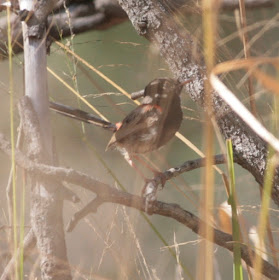 |
| Red-backed Fairy-wren in there somewhere |
5. Molle Islands National Park. We stayed at a wonderful little resort called Peppers Palm Bay, on Long Island. We were just offshore from Airlie Beach in the Whitsundays, a chain known for it's beautiful beaches, snorkeling, and proximity to the Great Barrier Reef. Most of Long Island outside of the resort, and some of the nearby islands, are part of Molle Islands National Park. Unfortunately, the islands have been hit hard by a couple of cyclones in the past few years (topical, as Hurricane Irma is currently plowing into Florida). Two other resorts on the island were closed at least partly as a result of hurricane damage, and the water was still too churned up with sand and sediment five months later to do any snorkeling. But, the island was beautiful, idyllic, and tropical. No complains.
 |
| Silver Gull on Long Island |
 |
| White-bellied Sea-eagle |
3. Daintree National Park. Lots of northeast Queensland is just stunning rainforest-covered mountains. Lots of it is protected, some as the Daintree National Park. It'd never been to a proper rainforest before, and I don't know if I ever want to go again for fear of a letdown. First, let me say this: there were no bugs. No bugs at all. I fully expected to be beset by deadly mosquitoes and god knows what the second I stepped out of my car, but even in the densest most remote areas we were perfectly clear. It's the winter dry season in Australia right now, and so that had a lot (everything?) to do with it, but our visit to the top of Mt. Lewis, where we strolled down a small path with parrots and fruit-doves and Chowchilla and singing birds I couldn't see at all echoed all around us without a bead of sweat on the brow or a bug on the arm was one of the most enjoyable few hours of the trip.
 |
| Mossman River |
The cherry on top -- as if I dared to ask for one -- was finding a Short-beaked Echidna crunching through the leaf-litter on the way out. I did a project on echidna in elementary school and chose it because it was the most exotic animal I could find. I didn't really think I'd come across one in Australia, and was overjoyed. Magnetic Island was the only place on the trip we wish we regretted not being able to stay longer.
1. Kakadu National Park. This large park in the Top End contains some spectacular scenery and a lot of history. Huge sandstone escarpments, some with waterfalls and pools, share the landscape with lush wetlands and billabongs. The waterfalls weren't much to speak of during the dry season (the bone-rattling drive down to Gunlom Falls resulted in a nice swim at the top but wasn't the gusher we'd hoped for), but the lack of water meant that wildlife (ahem, birds) were concentrated at the remaining wetlands. Our early-morning boat trip at Yellow Waters was unforgettable, bringing us close to thousands of Mapgie-geese and whistling-ducks (plumed and wandering), night-herons, Whistling Kites, sea-eagles, Water Buffalo, feral pig, terns, jacana, and other creatures. It was incredible.
We were also able to see some stunning Aboriginal rock art in a couple different parts of the park. I know almost nothing about Aboriginals or the history and relationship they have with white Australians, and so it was very interesting to visit a museum in the park dedicated to Aboriginal life and to see classic artwork on boulders throughout the park. We had an excellent time and there's a lot to go back and see, especially in the wet season (and with a 4x4).
 |
| the top of Gunlom Falls |
 |
| beautiful moth species resting on Aboriginal rock art |
Top Five Shorebirds
I was unreasonably excited to see shorebirds in Australia, especially ones I had kept a half-eye out for here in the U.S. and was therefore sort of familiar with from American field guides. The Esplanade along the waterfront at Cairns -- a beautiful local amenity that was always crowded with strolling, running, jogging, selfie-ing visitors -- had hosted about a dozen of desirable species, according to eBird, and fall migration was just getting underway down there. I did end up managing to see a bunch of shorebirds, but not quite as many as I wanted. Still, here are some cool ones.
5. Far Eastern Curlew. Like a Long-billed Curlew but even larger? Sign me up! Saw a bunch off the Cairns Esplanade.
4. Common Sandpiper. This is honestly a pretty boring bird, and looks (and acts) nearly identically to our Spotted Sandpiper in nonbreeding plumage, but I was thrilled to see one of these occasional American vagrants bopping along a beach on Magnetic Island.
3. Bush Stone-curlew (aka Bush Thick-knee). Not sure why different sources used different names here, but we saw a lot of these mischievous, expressive birds throughout the country. The favorite sighting was at an open-air café on our way back to Cairns, where these birds were just boldy waltzing between the tables looking for scraps.
 |
| -Waiter, there's a fly in my soup...do you want it? |
2. Black-fronted Dotterel. I was hoping for a bunch of cool little plovers and sandpipers and things like Red-capped Plover and sand-plovers (I did in fact see a Lesser Sand-plover in Darwin), but these gorgeous little dotterels made up for some of those misses. They're stunningly-plumaged and allowed for a close look.
1. Masked Lapwing. These chunkers were a near-constant presence where we were in the country, and are familiar in a number of suburban and rural habitats. Look at their waggily little faces!
Top Whatever Number of Butterflies
I saw some amazing butterflies, especially around Palm Bay resort and Long Island on the Whitsundays. I don't have a guide but used the very helpful Coffs Harbor Butterfly House website to ID to the best of my abilities. Here are some photos.
10. Striped Black Crow Euploea alcathoe
9. Clearwing Swallowtail Cressida cressida
8. Blue Tiger Tirumala hamata
7. Orange Bush Brown Mycalesis terminus
6. Spotted Skipper Hesperilla ornata
5. Tawny Coaster Acraea terpsicore in Townsville
4. Australian Rustic Cupha prosope on Long Island
3. Royal Jewel Hypochrysops polycletus seen on Long Island in the Whitsundays.
2. Cairns Birdwing. Seen at the Botanical Garden. Not my photo (obvi, because it's in focus).
1. Ulysses Butterfly. Liz and I saw a bunch of these around the Mossman River. They're STUNNERS, huge and electric blue and shining like flying Christmas lights. Again, not my photo.
Top Ten Mammals
It was a dream to see Australian mammals. I don't know what else to say. Even as I make fun of some of them.
10. Allied Rock-wallaby. These little farters were on Magnetic Island, looking kinda ratty, smelling bad, and eating tourist handouts. At least we got a close look.
9. Eastern Grey Kangaroo. The biggest marsupials we saw. These were the real deal, STRAIGHT UP KANGAROOS, and we couldn't wait to get to the spot we were told we'd find them: the Mareeba Golf Course. Well, they were there for sure. Just sort of standing there in the shade, not really moving, and not that close. It was kinda boring, not gonna lie.
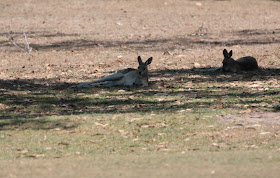 |
| oh hey |
8. Musky Rat Kangaroo. Haha talk about pulling the short straw in the ol' name department! "Ok, are we good with 'Rat Kangaroo?" "No, no, not needlessly insulting enough. It also stinks, let's get that in there. Musky Rat-kangaroo." Nevertheless, this is a very cool creature, one of the oldest marsupials in Australia, they say. We saw this one coming to scrounge feeder-scraps at Cassowary House.
7. Humpback Whale. Dannngg dude I'd seen Humpbacks before, but I wasn't prepared for this migrating mother (I think) and calf moving through a shallow channel between the mainland Airlie Beach and Long Island. I had my back turned trying to take a photo of some dumb bug or something and heard what I thought was a canvas sail catching in the wind - a loud thwacking. I didn't think much of it but finally turned around to see the adult whale slapping its fins in the water, with the baby practicing its breaching. Unreal.
6. Short-eared Rock-wallaby. Beautiful little bouncers we saw looking for shade under some rocks at Kakadu NP.
5. Platypus. PLATYPUS! I saw the second day, alone in the morning, on an idyllic little billabong out front of the Silky Oaks Lodge, but didn't get great looks. We went a few days later to Tarzali Lakes, a former fish farm that acquired a population of platypus after a flood. It's pretty touristy now, but you can't beat the guaranteed looks.
4. Agile Wallaby. This was the most common species of kangaroo we saw in Oz. They were all over the place. The best was watching them bound away when they got startled. So fast, so fast. But bouncing!
 |
| the handsomest wallaby in Australia |
3. Echidna. I was FRIGGING overjoyed, I can't even tell you. Sorry for the garbage photos.
2. Dingo. These dogs were introduced to Australia by Polynesians more than 4000 years ago, and have established themselves throughout the country. We saw one feeding on a carcass along the highway to Pine Creek. It was close at first, but ambled away when it saw me slam on the brakes and spin around. Unreal.
1. Koala. Unforgettable.
Top Five Misses
The hits aren't the hits unless you get a few misses, you know what I'm sayin? Incentive to go back.
5. Cockatiel. We had a bird when I was a kid, in a cage. A cockatiel that we named Larry Bird. (We were in Maine, and Celtics fans in the early 90s and so it was a funny and topical joke. My dad wanted to get another bird and name it Robert Parrot after Celtics teammate Robert Parrish but we never did.) I think a lot about what role Larry played in me becoming a birder, and I think ... not so much. I was young, and didn't really connect with the bird, and if anything felt guilty because he so clearly didn't want to be in a cage in our house. Every time we let him out he flew like mad trying to escape, and would hide in our houseplants for hours. We ended up giving him to my uncle, and he died. I would have loved to see a flock of cockatiels flying wild.
4. Terek Sandpiper, Red-capped Plover, and other shorebirds. Next time.
3. Australian Owlet-nightjar. Didn't really know where to be for these birds, but shit they look awesome.
2. Blue-faced Parrotfinch. The top of Mt. Lewis is the best spot for them, but it wasn't quite the right time of year.
1. Chestnut-quilled Rock-pigeon. Took a beating in the sun in Kakadu but came back empty.
Top Five Pigeons/Doves
There are a lot of doves and pigeons down there! More than I'm used to up here! Birding is fun as hell!
283493. Rock Pigeon. Ugh.
10. Spotted Dove. I done seen on in L.A. before...now I done seen one in Sydney.
9. White-headed Pigeon. Flyovers at Cassowary House.
8. Rose-crowned Fruit-dove. Cool bird, but heard only at Curtain Fig NP.
7. Peaceful Dove. Super common Inca Dove-type bird. Cool name. Pacifism wasn't immediately evident in the plumage.
6. Bar-shouldered Dove. Another very common bird, especially once I learned the call.
5. Crested Pigeon. Are you kidding me? Look at the point on this sonofagun! Looks like Ed Grimley.
4. Torresian Imperial-Pigeon. Beauties.
3. Topknot Pigeon. Pigeons with a man-bun! Lots flying around on top of Mt. Lewis, but I didn't get great looks.
2. Partridge Pigeon. This might be the most rare species I saw in the country, at a reliable location near the Jabiru Airport outside of Kakadu NP. Pretty cool birds, with their red eyes and all.
1. Wompoo Fruit-dove. I mean, we just don't have pigeons like this. Purple and green?? What a beauty.
Top Five Parrots or Parrot-like Birds
I wanted to just stop and shake everyone on the street and say "holy shit can you believe how many parrots are flying right over our heads?!"
9. Little Corella
8. Sulphur-crested Cockatoo
7. Red-winged Parrot
6. Northern Rosella
5. Gallah. Terrible picture of a beautiful bird. Pink and gray.
4. Red-tailed Black-Cockatoo
3. Rainbow Lorikeet. Literally everywhere. Rainbows were replaced in Darwin by their close cousins (eBird considers them just a subspecies), the Red-collared Lorikeet, second photo down.
1. Hooded Parrot. A stunning range-restricted species seen at their regular spot by the Boot Tree in Pine Creek.
 |
| female |
 |
| male |
 |
| young male |
Honeyeaters are sort of Australia's warblers. Lots of similar-looking birds with slight differences in their plumages presenting ID challenges to the birder. Especially the visiting one. None I saw (except New Holland) were quite as lovely as our warblers, but it was fun to dig in and see what I could get.
7. Yellow Honeyeater
6. White-plumed Honeyeater
5. Lewin's Honeyeater
4. Brown-backed Honeyeater
3. Bridled Honeyeater
2. Varied Honeyeater
1. New Holland Honeyeater
If you're still reading, let me know on Twitter and I've give you like $50. No, I won't, but this has been the longest post and I'm exhausted. There are a ton of birds I haven't talked about, but maybe another time. I miss Australia like hell and wish I were still there. The end.


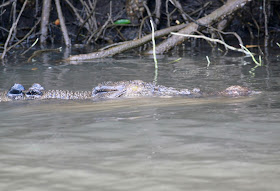

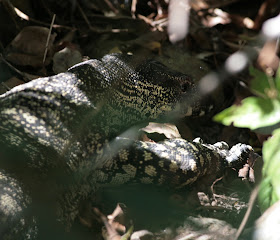








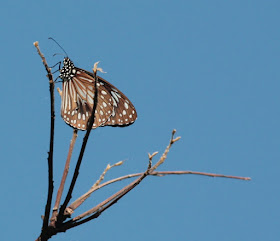


















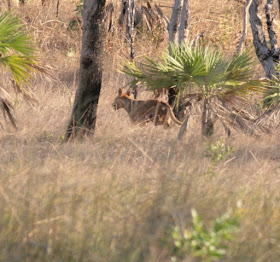
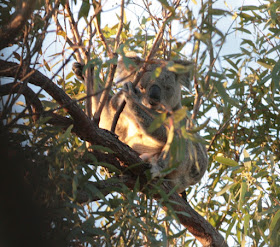







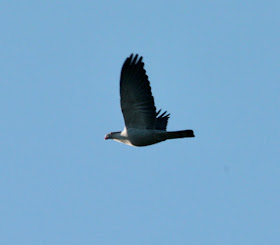










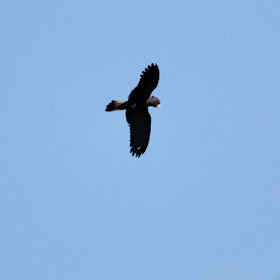










Great! I read it all, and you owe me like $50. THE BEST bird descriptor is now officially 'double-eyed.'
ReplyDeleteWell i understand many birds are named for their calls they make and australia has the Boo book Owl Tawny Frog Mouth and in Africa they have the Go Away Bird
ReplyDeleteMan, sorry, but calling crocodiles "lizards" is like calling tinamous "chickens" or swifts "swallows", it's completely wrong, the resemblance is only superficial.
ReplyDeleteYou're right, Andrew, crocodiles are not lizards. I purposefully meant to denigrate crocs, but should have found a better way.
ReplyDeleteI'm going to OZ for the first time in September and will go to Kakadu then on to Cairns and then drive the entire east coast to Adelaide. Loved the tips on everything. especially the birds. Thanks.
ReplyDelete